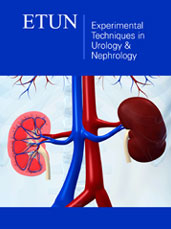- Submissions

Abstract
Experimental Techniques in Urology & Nephrology
Ethylene Glycol Induced Hyperoxaluria Increases Circulating Endothelial Cells in Peripheral Blood: A Possible Link of Urolithiasis to Cardiovascular Diseases
-
Open or Close Hakan Sarı1, Faruk Yencilek2, Gülderen Yanıkkaya Demirel4 and Hasan Aydın4*
1 Department of Internal Medicine, Bagcilar Education and Research Hospital, Turkey
2 Department of Urology, Yeditepe University, Turkey
3 Department of Immunology, Yeditepe University, Turkey
4 Department of Endocrinology and Metabolism, Yeditepe University, Turkey
*Corresponding author: Hasan Aydın, Department of Endocrinology and Metabolism, Yeditepe University Medical Faculty, Istanbul, Turkey
Submission: May 29, 2018; Published: July, 14, 2018

ISSN: 2578-0395Volume2 Issue2
Abstract
The aim of this study was to establish the role of hyperoxaluria on endothelial dysfunction by using Circulating Endothelial Cells (CECs). A total of 24 Sprague Dowley rats have been included into study. Group IA, B and C (n=6 in each): Hyperoxaluria-induced group; Group II (n=6): Control group. Rats were euthanized after collection of 24-hour urine samples for the analysis of oxalate excretion either at 24th hour (group A), 14th day (group B) or 28th day (group C) and blood samples were collected for the analysis of CECs. Rats in control group were euthanized after collecting 24-hour urine samples. CECs were determined via multicolor flow cytometric method with the help of rat anti-CD 146-PE antibodies together with CD31, CD45 and CD34 monoclonal antibodies. Compared to controls, the amount of CECs was found to be higher in hyperoxaluric group. Highest levels were achieved at day 14 (1.60±0.27, 1.93±0.42, and 1.20±0.20, 24-hour, 14-day and 28-day samples, respectively). The amount of CECs correlated positively with urinary oxalate excretion (p=0.002, r=0.679). Ethylene glycol-induced hyperoxaluria causes systemic endothelial dysfunction. This may contribute to the pathogenesis of increased risk of cardiovascular diseases in urolithiasis.
Keywords: Hyperoxaluria; Endothelial dysfunction; Circulating endothelial cells; Urolithiasis; Cardiovascular risk
Abbreviations: CECs: Circulating Endothelial Cells; ADMA: Asymmetrical Di Methyl Arginine; EDTA: Ethylene Diaminic Tetra acetic Acid
 a Creative Commons Attribution 4.0 International License. Based on a work at www.crimsonpublishers.com.
Best viewed in
a Creative Commons Attribution 4.0 International License. Based on a work at www.crimsonpublishers.com.
Best viewed in 







.jpg)






























 Editorial Board Registrations
Editorial Board Registrations Submit your Article
Submit your Article Refer a Friend
Refer a Friend Advertise With Us
Advertise With Us
.jpg)






.jpg)














.bmp)
.jpg)
.png)
.jpg)










.jpg)






.png)

.png)



.png)






